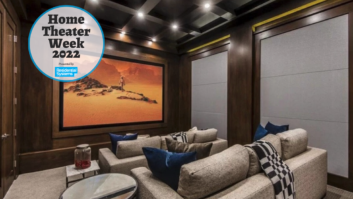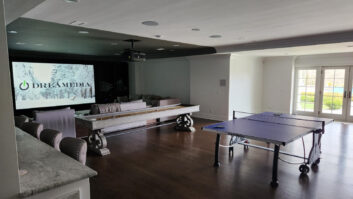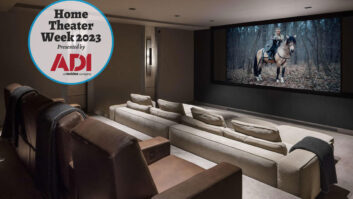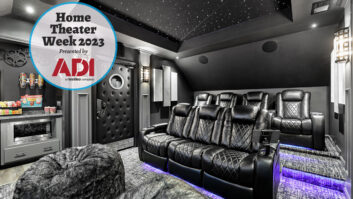This Integration Guide to Projectors and Screens was sponsored by Da-Lite, Draper, and Elite Screens as a supplement to Residential Systems, June 2013.

DPI’s recently unveiled addition to its TITAN line, the TITAN 1080p LED 3D, is the only three-chip LED projector available today, according to the company. Projection-based home theaters are still a staple of the residential integration market, even as development of flat-panel screens continues apace. For home theater enthusiasts, the limited available screen sizes of flat-panels moves them out of contention for a prized spot in the cinematic sweepstakes, while screen placement and lighting considerations often work in favor of the projector and screen duo.
“The growth in large format, flat-panel displays are putting pressure on the market for projection in the home, while at the same time calling attention to the features that have always differentiated projection, causing a renewed interest,” said Jennifer Davis, Runco’s VP of marketing. “The first and best example of this is the ability to change aspect ratios. It is impossible to install a 16:9 flatpanel television and change the aspect ratio of the screen when a 2.35:1 CinemaScope movie is played, without black bars.”
Indeed, the viewing flexibility that projectors and their companion screens afford end users, in addition to the growing number of proprietary and mass market technologies that are constantly improving the viewer experience, have supported this configuration as the elite standard for home theaters.

Elite Screen’s DarkStar ambient-light rejecting material is formulated for optimal color temperature and contrast in a well-lit room. “It’s an interesting time for projection because many people are caught up in the ‘more pixels’ buzz, in that there’s an assumption that today’s imaging solutions are somehow less impressive than the next trend,” noted Michael Bridwell, director of marketing for Digital Projection Inc. (DPI). “However, it’s important to understand that many present projection experiences can and should be better than they presently are. Thinking about the viewing environment, and choosing the right projector/lens combination to suit that environment, makes a massive difference in picture quality. Viewing distance per screen size is also important, as some projection technologies can produce less than stellar imagery depending on where you’re sitting.”
On Projectors
The continued relevance of projectors in the age of flat-panel displays is due in large part to their ability to produce equally as rich color output in spaces that have been traditionally hostile to projected images and content. Manufacturers like Epson, Runco, and Sony, among others, all currently have projectors on the market that they can boast rival flat-panel image output when comparing contrast ratios and response to ambient light.
At Epson, for example, the PowerLite Pro Cinema 6020UB is proving to be a consumer favorite with its 320,000:1 contrast ratio, 2,400 lumens of color brightness and 2,400 lumens of white brightness. According to Epson’s marketing manager, Jason Palmer, this makes the 6020UB a “powerful performer in dark dedicated theater rooms, as well as rooms with ambient light.”
Palmer continued, “We believe it performs as well as a projector more than twice its price, yet it leaves room in the budget for the rest of the customer’s system. Consumers often don’t know it, but the Pro Cinema 6020’s installation flexibility makes it a hit as well since integrators can use our Fujinon lens assembly’s remarkable lens shift to get a perfect image on the screen from nearly anywhere in the room.”
Palmer also touted Epson’s recently announce Pro Cinema 6030UB, which builds on the 6020UB by increasing contrast up to 600,000:1 and adding features such as black and white cinema mode to refine classic movies.
With a history of producing proprietary technologies, like CineWide, and accommodating home theater enthusiasts desires for a pro-cinema feel by incorporating anamorphic lenses into its projector optitns, Runco has stepped it up again with its LED-illuminated projectors, most notably the Quantum Color Series.
“The Runco QuantumColor Q-750 platform continues to be one of our most popular,” Davis said. “Lampless and quiet, the projector delivers amazing color contrast and has unique features like Runco SmartColor that allow enthusiasts to take advantage of a larger color space without some of the negative consequences [such as] brighter reds without altering skin tones. For purists who want to hit precise REC-709 color spaces, that is certainly one of the pre-sets as well.”

Screen Innovations’ Black Diamond Motorized consists of a slender, cable-hung motorized cassette that allows the screen to appear as though it is levitating in the space. Runco’s LightStyle LS-12 platform, available in a number of configurations, is also proving popular. The LS-12 offers high brightness for family room brightness installations, 3D to accommodate the increasing array of content in that format, and a configuration with Runco’s DC-300 processor, which is engineered to enhance 3D performance and offers a suite of calibration tools to adjust images.
Noting that 4K projection has driven the marketplace toward higher video performance in the home, Sony’s Andre Floyd, manager of the company’s Front Projector Group, pointed to the ES home theater 3D projector (VPL-HW50ES), which offers 100,000:1 dynamic contrast ratio, 1,700 ANSI lumen brightness, 240Hz panel drive, independent 2D and 3D calibration, 1080p, quiet fan, two pairs of 3D glasses, and an extra lamp.
“In 2011 at CEDIA, we launched the world’s first 4K home theater display, which was the VPL-VW1000ES,” Floyd said. “Some might say that it started a resolution revolution as other manufacturers began to offer 4K [front projectors], and we can all see what is happening in the ultra HD displays for the home.
With a marketing strategy that Bridwell said has residential integrators at the heart of its business, DPI continues to produce a range of LED projectors that all deliver 60,000 hours of illumination with no lamp replacement, great color performance, and an attractive cost of ownership value.
“In the near term, you’ll see advances in color space/brightness combinations that will knock your socks off,” Bridwell said, adding that the company’s recently unveiled addition to its TITAN line, the TITAN 1080p LED 3D, is “the only three-chip LED projector available today, producing imagery that, once experienced, is going to absolutely stun the viewer.”
For SIM2, the Grand Cinema series of projectors remain the company’s bestsellers. In the range, the Lumis-branded projectors are particularly popular and feature a three-chip 0.95 1080p DC4 DLP chipset, 5,000 lumens, and the company’s proprietary Trip Flash technology for 3D smoothness. Interestingly, Alberto Fabiano, executive vice president of SIM2 USA, said the company is not focusing on chip resolution.

Seymour-Screen Excellence is paying similar attention to screen design with the marketing of its slim-bezel fixed-frame, which measures approximately a half-inch wide and protrudes from the wall at 1.33-inches. “As high-resolution source material is still lacking, we are determined to offer to our customers a projector that provides the best picture money can buy with today and tomorrow’s technologies,” Fabiano said. “[One way is by] designing a projector that easily integrates into well-designed environments (not just a black box). A perfect example is our recently launched Crystal Cube. In alternative light sources, we are championing the category with our M.150 LED projector. Products that work well in brightly lit environments [offer] a good looking and better performing alternative to flat-panels.”
On Screens
“The holy grail of projection screen development is a material that will give LCD flat-panel performance in a well-lit room,” noted Elite Screens’ marketing manager, David Rodgers, summing up the ongoing mission of most projection screen manufacturers focused on developing pro-grade viewing surfaces for the home theater market.
With 4K as the next big evolution on the visual side of AV integration, both Stewart Filmscreen and Elite Screens have produced screens in anticipation.
“All current Stewart screen materials are 4K-plus capable, and have been for some time,” said Dave McFarland, director of marketing. “Stewart’s proprietary formulations and precision material manufacturing processes have been developed to support critical viewing applications in fields such as aerospace and medicine, producing screens that support line pair resolutions well above that of 4K.”

Sony’s ES home theater 3D projector (VPLHW50ES) offers 100,000:1 dynamic contrast ratio, 1,700 ANSI lumen brightness, 240Hz panel drive, independent 2D and 3D calibration, 1080p, quiet fan, two pairs of 3D glasses, and an extra lamp. For Stewart Filmscreen, the Director’s Choice and CineCurve fixed masking screens have been the biggest hits with integrators. CineCurve, as McFarland explained, comes in a native 2.4:1 aspect ratio, for movies shot in Cinemascope, and utilizes constant height vertical masking to mask down to HDTV (16:9) for watching sports or 4:3 for classic movies or TV shows, while the Director’s Choice systems have both vertical and horizontal masking systems, allowing end users to “right size” the image, given the content’s resolution and the viewer’s distance from the screen.
Elite Screens’ Prime Vision’s AcousticPro-4K has an angular weave designed to handle 4K and 1080p projectors while delivering a moiré-free viewing experience. Featuring an ultra-white front projection screen surface with a 1.1 gain, the AcousticPro-4K also has black cloth backing to eliminate backlighting artifacts from light bleed-through.
“Finely woven acoustically transparent materials are becoming more in demand to accommodate the high resolution levels of today’s home theater projectors,” Rodgers said. “Elite Prime Vision’s AcousticPro 4K has fulfilled this role nicely. The material comes in a variety of configurations, sizes, and aspect ratios.”
Acknowledging the rise in 3D’s popularity and accompanying technologies produced by 3D imaging companies that bring passive 3D systems within home theater budgets, Severtson Screens has created the SeVision 3D GX screen. With a signal to noise ratio up to 250:1 at a 2.4 gain to reduce the chances of ghosting, the screen is also water-based to prolong its life and can be used in 2D projection as well.
“Combining the eye popping realism of 4K projection technology with synchronized sound coming from behind the screen recreates the cinema experience in the home theater,” said Kirk Severtson, COO. “Severtson’s new SAT-4K material is woven to extremely tight tolerances, eliminating moiré while still maintaining its acoustic transparency. The weaving technology can also create much wider rolls of material, allowing us to manufacture seamless screens up to 15 feet 10 inches tall and as wide as needed.”
With an eye on home décor and how home theaters can better sit within active living spaces, Screen Innovations has enjoyed success with its Black Diamond series of screens, which include the Black Diamond Zero Edge and the more recent Black Diamond Motorized. The former, which company director of sales Blake Vackar noted “outsells the old school fixed frame version 11 to one,” features multi-directional ambient light rejecting technology that resembles the look and feel of a flatpanel television and is available in either black 0.8 gain, black 1.4 gain, or silver 2.7 gain screen materials, while the latter consists of a slender, cable-hung motorized cassette that allows the screen to appear as though it is levitating in the space.

Stewart Filmscreen’s Director’s Choice have both vertical and horizontal masking systems, allowing end users to “right size” the image, given the content’s resolution and the viewer’s distance from the screen. “With the introduction of Black Diamond Motorized, we upped the ante’ significantly and have provided the ultimate solution for any room, any space, any place; indoors or out,” Vackar said. “It’s the only screen or TV on the market that can enter or exit a space completely, yet provides an impressive and immersive large-format image in either light or dark environments. Men and women alike are drawn to its design. The slender aircraft cables that suspend the screen lend a stealthy appearance but it’s the disappearing act that provides the most appeal. Once people see it, they want it.”
Seymour-Screen Excellence is paying similar attention to screen design with the marketing of its slim-bezel fixed-frame, which measures approximately a half-inch wide and protrudes from the wall at 1.33-inches—a design that company spokesperson Paul Muto said makes for easier integration into home theaters and multi-purpose rooms, especially where the flat-panel display look is requested.
“The J-frame’s bezel is slimmer and narrower than the company’s RF series,” Muto explained. “J-frame measures 3.3-inches wide, with less protrusion from the wall (only 1.6-inches from wall to front of frame) than RF series’ 2.5-inch depth. The end-result is more flexibility when trying to fit a film screen into a constrained space, which is quite common today.”
Future Projections
The existence of home theaters is still an awe-inducing reality. As home entertainment content becomes not only cheaper, but also more abundant thanks to mutliple delivery highways (digital streaming, in particular) and access points (numerous cloud-based portals), home theaters, in their various forms from bat cave to solarium, will continue to be an optimal way to have a cinematic experience without having to leave the sofa.
Projectors and projection screens are significant contributors to that enhanced experience, especially as manufacturers continue to make product improvements that render the dynamic duo as attractive as flat-panel displays. With 4K resolution poised to become the standard across all consumer visual electronic products, projectors and screens are bound to expand into other areas, such as game rooms, where they currently have a smaller cache. With usability, expansion should come with even greater improvement in product performance, including better color output, richer contrast ratio, and longer lamp life in projectors. Screens, already thrilling in their ability to reject ambient light, will continue to build on those innovative surface materials to eliminate room placement as a hurdle in choosing projection as a home theater option.
Llanor Alleyne is contributing editor to Residential Systems, based in St. James, Barbados.
Leon Shaw
Founder & Chairman
Audio Advice, Raleigh, NC

What are your key considerations when recommending a projector for you clients?
Price, quality desired, and the room environment all play into a projector recommendation. With Epson, we rarely have to be concerned about throw distance or offset as they have such a wide range. This has come in really handy when we are replacing CRT projectors that had a shorter throw distance. With today’s projector technology, the price of admission for very good quality has dropped significantly. We typically recommend “decent” projectors, which leave a whole lot more room for the audio side of the theater system.
What features would you like to see in the future?
I would like to see more LED and other solid-state projectors on the market. I have one in my own home and love the picture and the fact it looks as good now as when I put it in two years ago. I’d also like to see native 2:35 panels become more affordable.
Anthony P. Pavia
Personal Cinema Architect Lights Camera Action (LCA SYSTEMS),
Ridgefield, CT
What are your key considerations when recommending a projector for you clients?
First and foremost, we require a performance level worthy of true cinema. We use DLP technology from Runco on Stewart Filmscreen exclusively. We also need high reliability, a physically beautiful product, and a range of model options to fit the scale of our jobs at various budget levels. In a recent project in a stately Richmond mansion, we used Runco’s flagship model SC-50. In this space the projector was visible on the ceiling. That’s unusual for us, but the client just loved the look of the product. He wanted to see his flagship Runco projector, Mark Levinson amplifiers, and Magico loudspeakers.
What features would you like to see in the future?
A good IP interface that includes remote diagnostics for all models would be great. We would like to see performance and lamp usage data on a dashboard to manage our live theater sites. I would also love to see a multiple setting iris on all of the cinema grade models, from the X200i and up, so a calibrated set could have a 2:1 change in light output without affecting the image characteristics by dimming lamps or changing video settings. I would also like to have a precise motorized lens memory system that allows us to have accurate constant height aspect ratios rendered for at least the top five cinematic formats.







